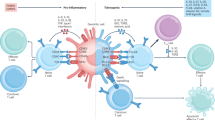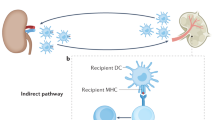Abstract
Our understanding of tolerance mechanisms has progressed to the point that tolerance-induction protocols are being tested in humans for organ transplantation. However, a range of scientific, ethical, logistic and commercial issues have arisen, and must be resolved before tolerance induction for human allograft patients can become a reality.
This is a preview of subscription content, access via your institution
Access options
Subscribe to this journal
Receive 12 print issues and online access
$209.00 per year
only $17.42 per issue
Buy this article
- Purchase on Springer Link
- Instant access to full article PDF
Prices may be subject to local taxes which are calculated during checkout


Similar content being viewed by others
References
Billingham, R.E., Brent L. & Medawar, P.B. Acquired immunological tolerance to foreign cells. Nature, 172, 603–606 ( 1953).
Chiller J.M., Habicht G.S. & Weigle W.O. Cellular sites of immunologic unresponsiveness. Proc. Natl. Acad. Sci. USA 65, 551– 556 (1970).
Sprent J., Schaefer, M., Lo D. & Korngold R. Functions of purified L3T4+ and Lyt-2+ cells in vitro and in vivo. Immunol. Rev. 91, 195–218 (1986).
Cobbold, S. & Waldmann, H. Skin allograft rejection by L3/T4+ and Lyt-2+ T cell subsets. Transplantation 41, 634–639( 1986).
Auchincloss, H. Jr., Mayer, T., Ghobrial, R. & Winn, H.J. T-cell subsets, bm mutants, and the mechanisms of allogeneic skin graft rejection. Immunol. Res. 8, 149–164 (1989).
Guerder, S. & Matzinger, P. A fail-safe mechanism for maintaining self-tolerance. J. Exp. Med. 176, 553– 564 (1992).
Rees, M.A., Rosenberg, A.S., Munitz, T.I. & Singer, A. In vivo induction of antigen-specific transplantation tolerance to Qa1a by exposure to alloantigen in the absence of T-cell help. Proc. Natl. Acad. Sci. USA 87, 2765–9 (1990).
Rosenberg, A.S., Mizuochi, T. & Singer, A. Analysis of T-cell subsets in rejection of Kb mutant skin allografts differing at class I MHC. Nature 322 , 829–831 (1986).
Ridge, J.P., Di Rosa F. & Matzinger, P. A conditioned dendritic cell can be a temporal bridge between a CD4+ T-helper and a T-killer cell. Nature 393, 474–578 ( 1998).
Bennett S.R. et al. Help for cytotoxic-T-cell responses is mediated by CD40 signalling. Nature. 393, 478–480 (1998).
Schoenberger, S.P., Toes, R.E., van der Voort E.I., Offringa, R. & Melief, C.J. T-cell help for cytotoxic T lymphocytes is mediated by CD40-CD40L interactions. Nature 393, 480–483 (1998).
Lechler, R.I., & Batchelor, J.R. Restoration of immunogenicity to passenger cell-depleted kidney allografts by the addition of donor strain dendritic cells. J. Exp. Med. 155, 31–41 (1982).
Lafferty, K.J., Bootes A., Dart, G. & Talmage, D.W. Effect of organ culture on the survival of thyroid allografts in mice. Transplantation 22,138–149 ( 1976).
Fangmann, J., Dalchau, R. & Fabre, J.W. Rejection of skin allografts by indirect allorecognition of donor class I major histocompatibility complex peptides. J. Exp. Med. 175, 1521–1529 (1992).
Auchincloss, H. et al. The role of "indirect" recognition in initiating rejection of skin grafts from major histocompatibility complex class II-deficient mice. Proc. Natl. Acad. Sci. USA 90, 3373– 3377 (1993).
Miller, J.F. et al. Induction of peripheral CD8+ T-cell tolerance by cross-presentation of self antigens. Immunol. Rev. 165, 267–277 (1998).
Kong, Y.M., Giraldo, A.A., Waldmann, H., Cobbold, S.P. & Fuller, B. Resistance to experimental autoimmune thy-roiditis: L3T4+ cells as mediators of both thyroglobulin-activated and TSH-induced suppression. Clin. Immunol. Immunopathol. 51, 38–54 (1989).
Powrie, F. & Mason, D. Ox-22 high CD4C T-cells induce wasting disease with multiple organ pathology: prevention by OX-22lo subset. J. Exp. Med. 172, 1701–1708 (1990).
Qin, S. et al. Infectious transplantation tolerance. Science 259, 974–977 (1993).
Weiner, H.L. et al. Oral tolerance: immunologic mechanisms and treatment of animal and human organ-specific autoimmune diseases by oral administration of autoantigens. Annu. Rev. Immunol. 12, 809– 837 (1994).
Groux H. et al. CD4+ T-cell subset inhibits antigen-specific T-cell responses and prevents colitis. Nature 389, 737–742 (1997).
Mitchell, G.F. & Miller, J.F. Cell to cell interaction in the immune response. II. The source of hemolysin-forming cells in irradiated mice given bone marrow and thymus or thoracic duct lymphocytes. J. Exp. Med. 128, 821– 823 (1968).
Bretscher, P. & Cohn, M. A theory of self-non-self discrimination. Science 169, 1042–1049 (1970).
Lafferty, K.J. & Cunningham A. A new analysis of allogeneic interactions. Aust. J. Exp. Biol. Sci. 53, 27–42 (1975).
Lenschow, D.J., Walunas, T.L. & Bluestone, J.A. The CD28/B7 system of T-cell costimulation. Annu. Rev. Immunol. 14, 233–258 (1996).
Foy, T.F., Aruffo, A., Bajorath, J., Buhlmann J.E. & Noelle, R.J. Immune regulation by CD40 and its ligand GP39. >Annu. Rev. Immunol. 14, 591–617 (1996).
Bellgrau, D. et al. A role for CD95 ligand in preventing graft rejection. Nature 377, 630–632 ( 1995).
Kang, S.M. et al. Immune response and myoblasts that express Fas ligand. Science 278, 1322–1324 ( 1997).
Matsui, H. et al. Induction of antigen-specific immunosuppression by CD95 cDNA-transfected 'killer' dendritic cells Nature Med. 5, 930–937 (1999).
Zhang, H. et al. Induction of specific T-cell tolerance by Fas-L expressing antigen-presenting cells. J. Immunol. 162, 1423– 1430 (1999).
Allison, J., Georgiou, H.M., Strasser, A. & Vaux, D.L. Transgenic expression of CD95 ligand on islet beta cells induces a granulocytic infiltration but does not confer immune privilege upon islet allografts Pro. Natl. Acad. Sci. USA 94, 3943– 394 (1997).
Gozzo, J.J., Wood, M.L. & Monaco, A.P. Use of allogeneic, homozygous bone marrow cells for induction of specific immunological tolerance in mice treated with anti-lymphocyte serum. Surg. Forum 21, 281– 284 (1970).
Monaco, A.P. Antilymphocyte serum, donor bone marrow and tolerance to allografts: the journey is the reward. Transplant Proc. 31, 67– 71 (1999).
Cobbold, S.P., Martin, G., Qin, S. & Waldmann, H. Monoclonal antibodies to promote marrow engraftment and tissue graft tolerance. Nature 323, 164–166 ( 1986).
Qin, S., Cobbold, S., Benjamin, R. & Waldmann, H. Induction of classical transplantation tolerance in the adult. J. Exp. Med. 169, 779–794 (1989).
Bachar-Lustig E., Rachamim, N., Li, H.W., Lan, F. & Reisner, Y. Megadose of T cell-depleted bone marrow overcomes MHC barriers in sublethally irradiated mice. Nature Med. 1, 1268–1273 (1995).
Sykes, M., Szot, G.L., Swenson, K.A. & Pearson, D.A. Induction of high levels of allogeneic hematopoietic reconstitution and donor-specific tolerance without myelosuppressive conditioning. Nature Med. 3, 783–787 (1997).
Bemelman, F, Honey, K., Adams, E., Cobbold, S.P. & Waldmann H. Bone marrow transplantation induces either clonal deletion or infectious disease tolerance depending on the dose. J. Immunol. 160, 2645–2648 ( 1998).
Leong, L.Y.W., Qin, S., Cobbold, S.P / & Waldmann, H. Classical transplantation tolerance in the adult. The interaction between myeloablation and immunosuppression. Eur. J. Immunol. 22, 2825– 2830 (1992).
Tomita,Y., Sachs- D.H., Khan, A. & Sykes, M. Additional monoclonal antibody (mAB) injections can replace thymic irradiation to allow induction of mixed chimerism and tolerance in mice receiving bone marrow transplantation after conditioning with anti-T cell mABs and 3-Gy whole body irradiation. Transplantation 61, 469– 477 (1996).
Nikolic, B. & Sykes, M. Bone marrow chimerism and transplantation tolerance. Curr. Opin. Immunol. 9, 634– 640 (1997).
Wekerle, T. et al. Extrathymic T cell deletion and allogeneic stem cell engraftment induced with costimulatory blockade is followed by central T cell tolerance. J. Exp. Med. 187, 2037– 2044 (1998).
Kawai, T. et al. Mixed allogeneic chimerism and renal allograft tolerance in cynomolgus monkeys. Transplantation. 59, 256– 262 (1995).
Starzl, T.E. et al. The lost chord: microchimerism and allograft survival. Immunol. Today 17, 577–584 (1996).
Wise, M.P, Bemelman, F., Cobbold, S.P, & Waldmann, H. Linked suppression can operate through indirect recognition. J. Immunol. 161, 5813–5816 (1998).
Schlitt, et al. The functional relevance of passenger leukocytes and microchimerism for heart allograft acceptance in the rat. Nature Med. 5, 1292–1297 (1999).
Benjamin, R.J. & Waldmann, H. Induction of tolerance by monoclonal antibody therapy. Nature 320 , 449–451 (1986).
Gutstein, N.L., Seaman, W.E., Scott, J.H. & Wofsy, D. Induction of immune tolerance by administration of mono-clonal antibody to L3T4. J. Immunol. 137,1127 ( 1986).
Qin, S. et al. Induction of tolerance in peripheral T cells with monoclonal antibodies. Eur J. Immunol. 20, 2737– 2745 (1990).
Waldmann, H. & Cobbold, S. How do monoclonal antibodies induce tolerance? A role for Infectious Tolerance? Annu. Rev. Immunol. 16, 619–644 ( 1998).
Isobe, M., Yagita, H., Okumura, K. & Ihara, A. Specific acceptance of cardiac allograft after treatment with antibodies to ICAM-1 and LFA-1. Science 255, 1125–1127 (1992).
Lenschow, D.J. et al. Long-term survival of xenogeneic pancreatic islet grafts induced by CTLA4-Ig. Science 257, 789– 792 (1992).
Parker, D.C. et al. Survival of mouse pancreatic islet allografts in recipients treated with allogeneic small lymphocytes and antibody to CD40 ligand. Proc. Natl. Acad. Sci. USA. 92, 9560– 9564 (1995).
Larsen, C.P. et al. Long-term acceptance of skin and cardiac allografts after blocking CD40 and CD28 pathways. Nature 38, 434–437 (1996).
Davies, J.D. et al. T cell regulation in adult transplantation tolerance. J. Immunol. 157, 529–533 (1996).
Chen, Z. K., Cobbold, S. P., Waldmann, H. & Metcalfe, S. Amplification of natural regulatory immune mechanisms for transplantation tolerance. Transplantation 62, 1200– 1206 (1996).
Wells, A.D. et al. Requirement for T-cell apoptosis in the induction of peripheral transplantation tolerance. Nature Med. 5, 1303–1307 (1999).
Thomas, F.T. et al. Reversal of naturally occuring diabetes in primates by unmodified islet xenografts without chronic immunosuppression. Transplantation 67, 846–854 ( 1999).
Armstrong, N. et al. Analysis of primate renal allografts after T-cell depletion with anti-CD3-CRM9. Transplantation 66, 5–13 (1998).
Kirk, A.D. et al. CTLA4-Ig and anti-CD40ligand prevent renal allograft rejection in primates. Proc. Natl. Acad. Sci. USA 94, 8789–8794 (1997).
Kirk, A.D. et al. Treatment with humanized monoclonal antibody against CD154 prevents acute renal allograft rejection in nonhuman primates. Nature Med. 5, 686–693 ( 1999).
Li, Y., Li, X.C., Zheng, X.X. & Strom, T.B. Blocking both signal 1 and signal 2 of T-cell activation prevents apoptosis of alloreactive T cells and induction of peripheral allograft tolerance. Nature Med. 5, 1298–1302 ( 1999).
Calne, R. et al. Prope tolerance, perioperative Campath 1H, and low-dose cyclosporin monotherapy in renal allograft patients. Lancet 351 , 1701–1702 (1998).
Author information
Authors and Affiliations
Rights and permissions
About this article
Cite this article
Waldmann, H. Transplantation tolerance—where do we stand?. Nat Med 5, 1245–1248 (1999). https://doi.org/10.1038/15197
Received:
Accepted:
Issue Date:
DOI: https://doi.org/10.1038/15197
This article is cited by
-
Human Chorionic Villous Mesenchymal Stem Cells Modify the Functions of Human Dendritic Cells, and Induce an Anti-Inflammatory Phenotype in CD1+ Dendritic Cells
Stem Cell Reviews and Reports (2015)
-
An update on regulatory T cells in transplant tolerance and rejection
Nature Reviews Nephrology (2010)
-
STAT-1 decoy oligodeoxynucleotide inhibition of acute rejection in mouse heart transplants
Basic Research in Cardiology (2009)
-
STAT-1 decoy oligonucleotide improves microcirculation and reduces acute rejection in allogeneic rat small bowel transplants
Gene Therapy (2007)
-
Islet cell transplantation today
Langenbeck's Archives of Surgery (2007)



